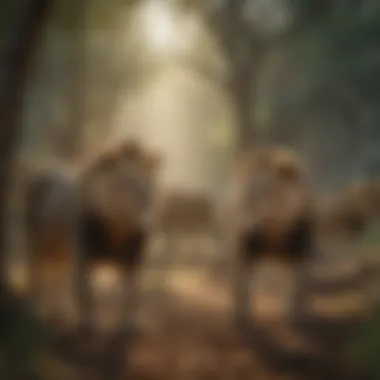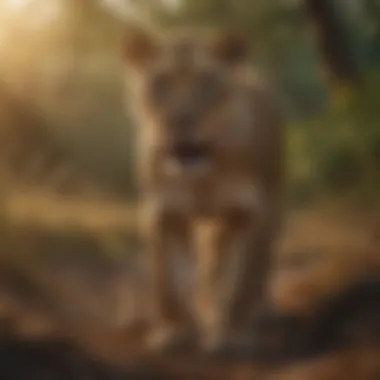Exploring the Unique Traits of Lions in Nature


Intro
Lions, known scientifically as Panthera leo, captivate many with their majestic appearance and complex social structures. They are not just symbols of strength and courage; these big cats play a crucial role in maintaining the balance of their ecosystems. Understanding lions involves a thorough look at their behavior, physiology, and social interaction, as well as the wider ecological context.
This guide delves into the unique characteristics of lions, shedding light on how they communicate, hunt, and raise their young. Additionally, it highlights the conservation issues they face in the wild, emphasizing the urgent need to protect their habitats and maintain the biodiversity within their ecosystems. By examining these factors, we aim to present a nuanced perspective on these iconic animals.
Prologue to Lions
Lions are majestic creatures that captivate the imagination. Understanding their characteristics is essential for several reasons. First, this knowledge can foster a greater appreciation for these animals and their role in the ecosystem. Lions, as apex predators, play a vital role in maintaining the balance of their habitats. Second, many regions face significant threats to lion populations. By understanding their behavior, habitat, and social structures, conservation efforts can be more effectively tailored. This article aims to provide an in-depth view of lions, emphasizing their ecological relevance and the challenges they face in the wild.
Overview of Panthera leo
The lion, scientifically known as Panthera leo, is one of the most recognized members of the Felidae family. These animals are notable not only for their physical prowess but also for their intricate social structures. Unlike other big cats, lions live in groups known as prides, which consist of related females, their offspring, and a small number of adult males. This social behavior significantly influences their hunting patterns, territorial behavior, and overall lifestyle. The lion holds a prominent position not only in the animal kingdom but also in various cultures around the world.
Distribution and Habitat
Lions historically roamed across Africa, Europe, the Middle East, and parts of Asia. Today, their distribution has significantly diminished.
Current ranges
Currently, lions are mainly found in sub-Saharan Africa, with small populations existing in India, specifically the Asiatic lion in the Gir Forest. This limited range is largely due to habitat loss and human interference.
Key characteristic: Sub-Saharan Africa serves as a stronghold for lion populations. This environment offers vast savannas and grasslands that are conducive to hunting and socializing.
Unique feature: The reduction in lion populations poses a challenge for biodiversity. Their current ranged locations face threats from poaching and habitat encroachment, directly impacting their survival.
Preferred environments
Lions prefer open habitats, including savannas, grasslands, and scrublands. These areas provide abundance in prey and adequate open space for hunting.
Key characteristic: The preference for open spaces aids their hunting strategies. This terrain allows lions to stalk their prey effectively, maximizing their chances of a successful hunt.
Unique feature: The preferred environment influences group social behaviors and dynamics. Lions adapt their social structures within these preferred environments, promoting cooperative hunting and increased survival rates.
Physical Characteristics of Lions
The physical traits of lions are fundamental to their identity. These characteristics reflect their adaptations and play a crucial role in their survival, social structures, and ecological roles. Understanding these attributes provides better insight into how lions thrive in their habitats. Not only do these traits define their appearance, but they also influence their behavior and interactions within their ecosystems.
Body Size and Weight
Body size and weight are key elements in understanding how lions function in their environment. Lions exhibit sexual dimorphism, which means males and females differ significantly in size. This not only affects their roles within the pride but also their hunting strategies and territorial behaviors.
Female vs. male size
Male lions typically weigh between 330 to 550 pounds, considerably heavier than female lions, who generally weigh between 265 to 400 pounds. This size difference contributes to their roles. Males are often responsible for territorial protection, leveraging their larger size to fend off rivals. Females, while smaller, are agile hunters. The difference in size allows for various strategies within pride dynamics.
This size distinction is vital for survival and breeding. Females are essential for the continuation of the pride, while males engage in ensuring their lineage through dominance and protection. Hence, this characteristic is a cornerstone of lion behavior.
Weight variations
Weight variations can be observed depending on the individual's age, health, and environmental conditions. Typically, well-fed lions weigh significantly more than those struggling for food. Weight is an indicator of health and strength. Stronger lions tend to hunt more effectively and compete better for mating opportunities.
Lions in different regions can display varying weights, influenced by the availability of prey and competition. An understanding of these variations allows researchers and conservationists to evaluate ecosystems' health and stability. Thus, monitoring weight variations becomes essential for effective conservation efforts.
Coloration and Fur
Coloration and fur play a significant role in how lions interact with their environment. These attributes not only define their aesthetic appeal but also serve practical purposes related to survival and social structures.
Coat variations
The coat of a lion can range from light buff to dark, depending on genetics and environmental factors. This variation serves two main purposes: it aids in camouflage and offers social information to other lions. A darker coat can indicate a lion's age or health status. Freshness and brightness of the coat often represent vitality, making them more attractive to potential mates, while darker tones could signal dominance.
Adaptations in coat coloration can facilitate hunting tactics when stalking prey. A well-camouflaged lion can reduce the chances of being detected by prey animals, thus increasing hunting success. Diversifying coat patterns also enables social signaling among pride members, strengthening social bonds and hierarchy within groups.


Seasonal changes
Seasons impact the coloring and texture of a lion's fur. During hot months, a lion's coat may thin, revealing softer and lighter layers. Conversely, in cooler periods, the coat thickens, providing necessary insulation. These adaptations ensure that lions remain healthy and functional in diverse climatic conditions.
Variations due to seasons also affect social interactions. During mating seasons, the richness of a male's coat can attract females, while during tougher survival conditions, resilience and adaptability take precedence. Thus, understanding these changes is essential for comprehending the overall behavior and health of lion populations.
Mane Characteristics
The mane is a distinctive feature of male lions and serves important ecological and social functions. Its presence can greatly influence a lion's life, affecting everything from mating success to social dynamics within a pride.
Purpose of the mane
The mane serves multiple purposes, mainly associated with protection and attraction. A robust mane acts as a cushion during fights with other males, safeguarding vital areas of the body. Furthermore, the magnitude and quality of a lion's mane can signal fitness levels to females and competing males. A fuller and darker mane is commonly perceived as a sign of health and genetic superiority, thus enhancing mating opportunities.
This characteristic fosters social hierarchy within prides and influences competition. The mane reflects the lion's status, playing a crucial role in interactions and behavioral patterns, ultimately impacting reproduction and survival rates.
Mane variation among males
Mane variation exists between individual male lions, influenced by genetics, health, and environmental factors. These variations can affect their standing within a pride and how they interact with other males. Males with shorter or less impressive manes may face challenges in asserting dominance.
This variation contributes to unique social structures within lion populations. Some prides may favor males with certain mane characteristics, affecting their success in matings. Understanding these differences allows for a deeper appreciation of lion social behaviors and dynamics, as well as insights into the implications of genetic diversity within populations.
"The characteristics of lions—from their physical traits to their social behaviors—are intricately linked to their environments and ecological significance."
In summary, the physical characteristics of lions encapsulate critical elements of their existence. Each trait serves a purpose that is essential for their survival, reproduction, and social interactions.
Behavioral Traits
The behavioral traits of lions are critical for understanding their ecology and social structure. Behavior reflects their adaptability and strategies for survival. This section discusses how these traits impact their hunting, social relationships, and communication methods.
Hunting Strategies
Lions are known for their effective hunting strategies, which are essential for their survival.
Group hunting tactics
Lions often hunt in groups, utilizing teamwork to take down larger prey. This collaborative approach enhances their chances of securing food. Each member of the pride plays a role, from stalking to ambushing. The key characteristic of group hunting is its efficiency. By working together, lions can target bigger animals, like buffalo or wildebeest.
A unique feature of this tactic is the division of labor. For example, some lions may distract the prey while others prepare to strike. This strategy has clear advantages, such as increased success rates in hunting. However, it also has disadvantages, including higher energy expenditure and dependency on pride cooperation.
Prey selection
The selection of prey is vital for lions’ survival. Lions tend to target herbivores that are abundant in their habitat. Their choice of prey can impact their overall health and the dynamics of the ecosystem.
One of the key characteristics of prey selection is the preference for larger animals, which are more energy-dense. This choice benefits lions as it maximizes their energy intake per hunt.
A unique aspect of prey selection is its variability based on seasons and availability. Lions may shift their targets based on what is most plentiful. This flexibility works to their advantage, though it can also lead to competition with other predators for food resources.
Social Behavior
Social behavior in lions is characterized by their complex pride dynamics.
Pride dynamics
Lions live in groups known as prides. The structure of a pride plays a significant role in their social behavior. Typically, a pride consists of several related females and their offspring, along with a few males. The key characteristic of pride dynamics is strong social bonds among females. This results in cooperative child-rearing and hunting.
One unique feature of pride structure is the male takeover phenomenon. When a new male enters a pride, he may kill the cubs sired by the former male. This act can temporarily disrupt the social structure and create stress within the pride but ensures that his genes are passed on.
Role of females in social structure
Females are central to the pride's functioning. They are primarily responsible for hunting and raising the cubs. The key characteristic of females' roles is their cooperative behavior. They work together to care for young and defend the pride territory. This cooperation benefits their survival and that of their offspring.
A unique feature of females’ roles is the ability to form alliances with other females. These connections provide stability within the pride and can enhance hunting success. However, this dependence also has disadvantages; conflicts can occur if resources are limited, leading to tensions within the pride.


Communication Methods
Effective communication is crucial for lions, facilitating social interactions and coordination during hunts.
Vocalizations
Lions use a variety of vocalizations to communicate. Roars serve to establish territory and signal the location of pride members. The key characteristic of vocalizations is their frequency and volume, which can carry over long distances.
A unique aspect of these vocalizations is their context. Different sounds indicate various emotions, from aggression to mating calls. This versatility helps maintain social bonds and coordinate group activities. However, vocalization can also draw the attention of rival prides or other predators, so timing and context are important.
Body language
Body language is another important method of communication among lions. The way a lion holds its head, ears, and tail conveys information to others. The key characteristic of body language is its subtlety. For example, a raised tail can indicate excitement, while flattened ears may show submission or fear.
A unique feature of this non-verbal communication is its role in social hierarchies. Body postures can denote dominance or submission, influencing interactions within the pride. Although body language is less commonly studied, it plays a vital role in how lions navigate their complex social structures.
Reproductive Characteristics
Understanding the reproductive characteristics of lions is essential in comprehending their role in the ecosystem and their overall survival. This section aims to highlight the unique elements of lion reproduction, including the mating rituals and the development of cubs. The reproductive cycle directly impacts the genetic diversity, social structure, and population dynamics of lion prides, which are crucial for maintaining healthy populations.
Mating Rituals
Mating rituals of lions are intricate and involve various behaviors essential for successful reproduction. During mating season, dominant males establish their presence in a territory through roaring and scent marking. Female lions, on the other hand, go into estrus and exhibit specific behaviors to signal their readiness to mate.
The courtship involves:
- Chasing: Males follow females, attempting to impress them.
- Vocalizations: Both partners may vocalize, indicating their mutual interest.
- Physical Displays: Males often display strength through mock fighting to gain the female's confidence.
This ritual can also solidify the bond between the male and the females of the pride, influencing pride dynamics.
Gestation and Cubs
The gestation period for lions typically lasts about 110 days, after which the female gives birth to a litter usually containing one to four cubs. The cubs are born blind and depend entirely on their mother for survival. Gestation is critical not only for the birth process but also for the future of the pride.
Cub rearing
Cub rearing is fundamentally important in lion society. Lionesses often share responsibilities, allowing for a collective approach to raising young. This communal care enhances cub survival rates. Female lions lactate for about six months, providing essential nutrition. Additionally, they teach cubs essential skills necessary for hunting and survival.
- Key characteristics of cub rearing:
- Social Learning: Cubs learn through observation of adults.
- Protective Nature: Adult females will fiercely protect their cubs from threats.
This approach enhances the survival of the pride, ensuring future generations remain viable.
Survival rates
Survival rates of cubs are influenced by various factors, particularly environmental pressures and their mother's ability to provide adequate care. Approximately 50% of lion cubs do not survive to adulthood due to predation or resource scarcity.
Key considerations related to survival rates include:
- Mortality Causes: Major threats come from other predators like hyenas or rival lions.
- Health and Nutrition: Healthy mothers produce healthier cubs, increasing their chances of survival.
Survival rates serve as a vital statistic in family dynamics and contribute to understanding the reproductive success of a pride, thus revealing much about their ecological role.
"Understanding the reproductive characteristics of lions is essential for their conservation and management programs, as these traits dictate population dynamics and social structure."
Ecological Role
The ecological role of lions is vital for maintaining the balance within their habitats. As apex predators, lions play a significant part in shaping the ecosystems they inhabit. They regulate prey populations, which is crucial in preventing overgrazing and ensuring that plant communities can thrive. Additionally, lions contribute to the overall health of the ecosystem by influencing the behavior and distribution of their prey, thus maintaining diversity within their habitats.
Top Predators
Lions are often referred to as top predators within their ecological context. This status is essential for several reasons. First, it allows them to dominate their food web, ensuring that weaker species are kept in check. This predatory behavior fosters a healthy ecosystem, as various herbivore populations experience natural regulation.


The presence of lions can lead to increased biodiversity as smaller carnivores often thrive in environments where lions exist. Through their hunting practices, they create space and resources for other species to flourish.
Impact on Ecosystems
The impact of lions on ecosystems extends beyond basic predation. By exerting pressure on herbivore populations, they play a role in shaping the landscape itself. The hunting patterns of lions directly influence which species flourish and which decline, thus promoting ecological balance.
Prey population control
Prey population control exemplifies how lions maintain ecological equilibrium. By selectively hunting certain species, lions prevent herbivore populations from exploding. This regulation is key to avoiding resource depletion and habitat degradation. Healthy prey populations lead to a stable ecosystem, allowing vegetation to thrive.
Moreover, this predation pressure affects the movement and behavior of prey animals, further contributing to ecological health. Consequently, it is a notable characteristic to discuss, as it highlights the importance of lions in keeping the natural order intact.
- Key Characteristics of Prey Population Control:
- Selective predation maintains herbivore balance.
- Promotes survival of various plant species.
Influence on biodiversity
Lions' presence significantly influences biodiversity. This influence is illustrated by how their hunting impacts the entire food web. By controlling prey populations, lions help to maintain habitats that support a variety of species.
In regions where lions are prevalent, studies show that there tends to be greater species richness among both flora and fauna. This aspect is important for sustaining ecological processes and improving resilience against environmental changes.
- Key Aspects of Influence on Biodiversity:
- Enhances habitat complexity.
- Supports various ecological niches.
Conservation Status
The conservation status of lions is a vital part of understanding these majestic creatures. Their numbers have dwindled in recent years due to a combination of factors affecting their survival. Recognizing these challenges can lead to better strategies for conserving lion populations and, by extension, the ecosystems they inhabit. In this section, we will analyze the significant threats to lions and the ongoing conservation efforts aimed at protecting them.
Threats to Survival
Habitat loss
Habitat loss is a central concern for lion survival. The conversion of land for agriculture, urban development, and other human activities significantly disrupts their natural environments. As these areas shrink, lions are forced into smaller territories, often leading to increased competition for resources. This situation can result in greater conflicts with humans, as lions may venture into populated areas in search of prey.
The main characteristic of habitat loss lies in its direct impact on lion populations. As their roaming space decreases, the potential for genetic diversity declines. This poses a risk of inbreeding, which can lead to health issues. Moreover, some unique features of habitat loss include fragmentation. Fragmented habitats create isolated populations which might struggle to find mates. This creates a vicious cycle leading to further population decline.
Human-wildlife conflict
Human-wildlife conflict is another significant threat to lions. As human populations expand, the interactions between lions and humans rise. Livestock predation by lions can provoke retaliatory killings from farmers, which leads to further declines in lion populations. This issue is particularly pressing in areas where livestock farming is prevalent, leading to a direct confrontation between economic needs and wildlife conservation. The key characteristic of human-wildlife conflict is its dual nature. While lions are often seen as threats, they play a crucial role in maintaining ecosystem balance. One unique feature of this conflict is the response of local communities. While some communities advocate for protective measures, others may resort to killing lions to safeguard their livestock. This divergence in perspectives illustrates the challenges in aligning conservation goals with human interests.
Conservation Efforts
Protected areas
Protected areas are essential for lion conservation. These reserves provide safe havens where lions can thrive without the immediate threat of habitat destruction or hunting. National parks and wildlife reserves serve as strongholds for lion populations, allowing for natural behaviors and reproductive activities to unfold.
The significant characteristic of protected areas is their capacity to offer long-term security for wildlife. Some unique features include established management plans that oversee the ecosystem's health. However, protected areas also have disadvantages. Management can be resource-intensive, and poaching activities often persist even within these areas. Balancing security with community engagement is key.
Community involvement
Community involvement in conservation efforts is proving to be effective in protecting lions. Local communities often serve as the first line of defense against threats like poaching. When communities are engaged and educated about the importance of lions, they can better protect them. Moreover, involving communities can lead to sustainable tourism practices that benefit both people and wildlife. The main characteristic of community involvement is its potential to create shared responsibility for conservation. Unique features include programs that offer compensation for livestock losses due to lions, creating incentives for coexistence. However, challenges exist, such as ensuring fair compensation and maintaining ongoing community engagement. Overall, this approach underscores the necessity of integrating human perspectives into conservation strategies.
"Effective conservation cannot occur in isolation. Communities must be considered as active participants rather than passive observers in the preservation of lions."
By addressing the various threats and highlighting the importance of concerted conservation efforts, we can strive to ensure a sustainable future for lions.
Culmination
In summing up the intricate characteristics of lions, it is essential to recognize their significance not only as individuals but also as a species within the broader ecosystem. This article has unveiled various aspects of lions, focusing on their physical traits, behavioral patterns, and social dynamics. Each of these elements contributes to a comprehensive understanding of what lions are and why they matter.
One critical aspect discussed is the ecological role of lions as apex predators. Their presence influences prey populations and maintains a balance within the ecosystem. This natural balance is crucial for biodiversity and the overall health of their habitats.
Furthermore, understanding lions helps illuminate the challenges they face, such as habitat loss and human-wildlife conflict. These challenges highlight a pressing need for effective conservation efforts. By taking actionable steps, such as establishing protected areas and fostering community involvement, we can work toward securing a future for lions and ensuring their vital role in ecosystems remains intact.
- Lions as Indicators: Their health reflects the health of the environment.
- Conservation Implications: Protecting lions leads to protecting many other species.
The synthesis of information presented throughout this article underscores the intertwined nature of lions and their ecosystems. Recognizing their importance encourages informed discussions and decisions surrounding wildlife conservation strategies. Ultimately, the survival of lions resonates with the commitment to preserving biodiversity and protecting the delicate balance of nature.
Understanding lions emphasizes the intricate dependencies that exist within our ecosystems, making it a crucial component in ecological studies and conservation efforts.
By fostering an informed perspective on the characteristics and challenges of lions, we can hope to engage more individuals in significant conservation work. Their fate is inextricably linked to the vitality of their habitats, urging us to act decisively to protect them.







